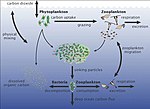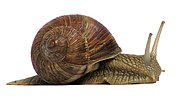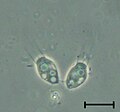 | A protist (/ˈproʊtɪst/ PROH-tist) or protoctist is any eukaryotic organism that is not an animal, land plant, or fungus. Protists do not form a natural... 94 KB (9,774 words) - 16:29, 6 May 2024 |
 | Microfossil (redirect from Micro-fossil) Gunflint microfossils Macrofossil Protists in the fossil record Protist shell Scale microfossils Small carbonaceous fossil Slater, Ben J.; Harvey, Thomas... 61 KB (6,330 words) - 03:19, 16 February 2024 |
 | Taxonomy of Protista (section Endomyxa Cavalier-Smith 2002, emend. Bass & Berney in Adl et al. 2019) A protist (/ˈproʊtɪst/) is any eukaryotic organism (one with cells containing a nucleus) that is not an animal, plant, or fungus. The protists do not form... 187 KB (15,311 words) - 03:03, 15 May 2024 |
 | Xenophyophorea (section Fossil record) Legouta, Anton (2003-03-31). "Ediacaran biota: The dawn of animal life in the shadow of giant protists". Paleontological Research. 7 (1): 43–54. doi:10... 35 KB (3,883 words) - 23:38, 7 March 2024 |
 | Paleontology (redirect from Fossil taxon) Paleobotany studies fossil plants, algae, and fungi. Palynology, the study of pollen and spores produced by land plants and protists, straddles paleontology... 103 KB (10,289 words) - 20:56, 14 May 2024 |
 | Marine life (redirect from Life in the ocean) typically macroscopic. Most protists are single-celled and microscopic. But there are exceptions. Some single-celled marine protists are macroscopic. Some marine... 304 KB (29,027 words) - 07:48, 15 May 2024 |
 | Ediacaran biota (redirect from Ediacaran fossils) as the Cambrian explosion. Most of the currently existing body plans of animals first appeared in the fossil record of the Cambrian rather than the Ediacaran... 104 KB (11,018 words) - 14:17, 1 May 2024 |
 | Marine microorganisms (section Marine protists) protists, but recent studies in marine environments found mixotrophic protests contribute a significant part of the protist biomass. Since protists are... 232 KB (21,384 words) - 06:01, 14 April 2024 |
 | Vendobionta (section Comparison with protists) correspond to the articulated ones. This type of symmetry is not typical in animals; instead, it has been observed in other vendobionts, protists, multicellular... 22 KB (2,550 words) - 14:41, 15 May 2024 |
 | Largest organisms (section Protists) photosynthetic unicellular and multicellular protists that are related to land plants. The thallus of the unicellular mermaid's wineglass, Acetabularia... 22 KB (2,926 words) - 01:03, 1 May 2024 |
 | Foraminifera (section Variations in reproductive mode) are single-celled organisms, members of a phylum or class of Rhizarian protists characterized by streaming granular ectoplasm for catching food and other... 86 KB (8,432 words) - 03:59, 12 May 2024 |
 | Dictyochales (category Taxa described in 1894) The silicoflagellates (order Dictyochales) are a small group of unicellular photosynthetic protists, or algae, belonging to the supergroup of eukaryotes... 16 KB (1,165 words) - 15:01, 11 April 2024 |
 | Radiolaria (section Fossil record) unicellular predatory protists encased in elaborate globular shells usually made of silica and pierced with holes. Their name comes from the Latin for "radius"... 27 KB (2,546 words) - 14:18, 11 January 2024 |
 | Nassellaria (section Fossil History) aesthetically interesting protists both alive and in the fossil record. They occupy an important role ecologically and have done so since the Precambrian. There... 11 KB (1,154 words) - 19:02, 20 November 2023 |
Journal of Foraminiferal Research, Cushman Foundation Loeblich & Tappin, 1964. Treatise on Invertebrate Paleontology, Part C Protists in the fossil record... 48 KB (2,149 words) - 00:22, 2 August 2023 |
Paleodictyon nodosum (category Trace fossils) Paleodictyon nodosum may actually be a large protist. There are other known examples of protists reaching the sizes that Paleodictyon reaches, and they are... 10 KB (1,272 words) - 02:01, 7 November 2023 |
 | Eukaryote (category All Wikipedia articles written in American English) are typically unicellular. Unicellular eukaryotes are sometimes called protists. Eukaryotes can reproduce both asexually through mitosis and sexually through... 61 KB (6,038 words) - 17:05, 12 May 2024 |
 | Taxonomy of commonly fossilised invertebrates (category Fossils) overview of various invertebrate taxa found in the fossil record, ranging from protists to arthropods. The taxonomy discussed emphasizes invertebrates... 19 KB (1,588 words) - 22:36, 17 March 2024 |
 | Wastebasket taxon (section Wastebasket taxa in science) Roy E.; Wagner, Peter J. (2006). "Round up the Usual Suspects: Common Genera in the Fossil Record and the Nature of Wastebasket Taxa". Paleobiology. 32... 10 KB (1,210 words) - 18:55, 14 April 2024 |
 | Multicellular organism (section Gene expression changes in the transition from uni- to multicellularity) organisms are the result of many identical individuals joining together to form a colony. However, it can often be hard to separate colonial protists from true... 42 KB (4,643 words) - 19:47, 25 April 2024 |
 | to archaea, bacteria, protists and microscopic pollen/spores. See also microfossils and palynology. Paleovirology examines the evolutionary history of... 15 KB (1,818 words) - 13:54, 26 March 2024 |
 | Marine protists Marine protists are defined by their habitat as protists that live in marine environments, that is, in the saltwater of seas or oceans... 131 KB (10,542 words) - 04:29, 6 January 2024 |
 | Invertebrate paleontology (redirect from Invertebrate fossils) discipline is the scientific study of prehistoric invertebrates by analyzing invertebrate fossils in the geologic record. By invertebrates are meant the non-vertebrate... 11 KB (1,212 words) - 22:50, 1 May 2022 |
are also common throughout the Cambrian fossil record. Taphonomic studies indicate that embryos are preserved for longest in reducing, anoxic conditions... 9 KB (926 words) - 21:54, 12 July 2023 |
 | Mollusca (category Wikipedia articles incorporating a citation from the 1911 Encyclopaedia Britannica with Wikisource reference) of molluscs are recognized. The number of fossil species is estimated between 60,000 and 100,000 additional species. The proportion of undescribed species... 93 KB (9,446 words) - 12:00, 14 May 2024 |




